1 min read
Southern Ring Nebula (NIRCam Compass Image)
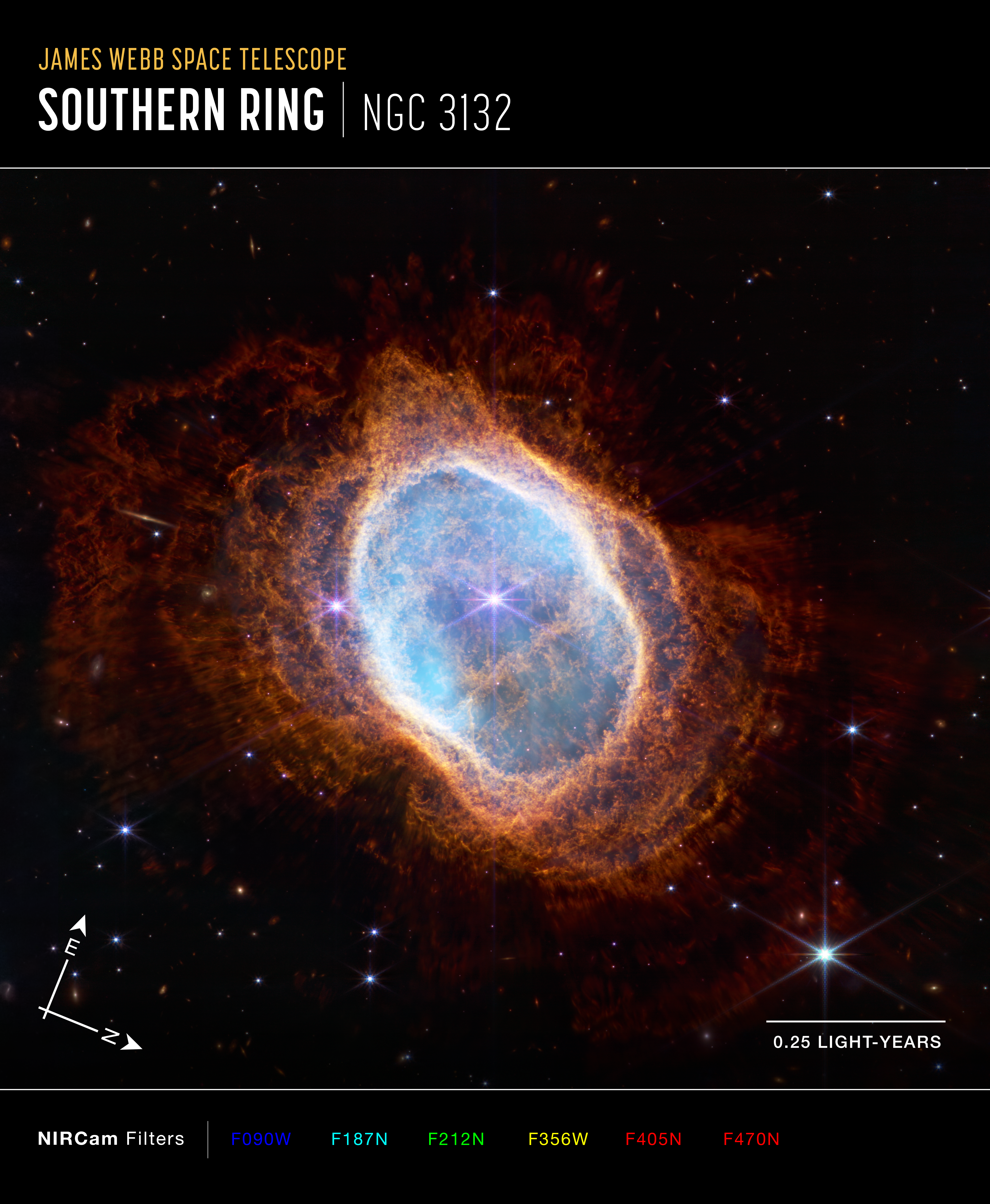
This image of the Southern Ring Nebula (NGC 3132), captured by Webb’s Near-Infrared Camera (NIRCam), shows compass arrows, scale bar, and color key for reference.
The north and east compass arrows show the orientation of the image on the sky. Note that the relationship between north and east on the sky (as seen from below) is flipped relative to direction arrows on a map of the ground (as seen from above).
The scale bar is labeled in light-years, which is the distance that light travels in one Earth-year. (It takes 0.25 years for light to travel a distance equal to the length of the scale bar.) One light-year is equal to about 5.88 trillion miles or 9.46 trillion kilometers. The field of view shown in this image is approximately 1.4 light-years across.
This image shows invisible near-infrared wavelengths of light that have been translated into visible-light colors. The color key shows which NIRCam filters were used when collecting the light. The color of each filter name is the visible light color used to represent the infrared light that passes through that filter.
Extended Description and Image Alt Text
Extended Description
Image titled “James Webb Space Telescope; Southern Ring NGC 3132,” with compass arrows, scale bar, and color key.
Image
Colorful image of near-infrared light from a glowing cloud with a distorted ring-like shape, illuminated from within by a bright central star. The Southern Ring Nebula is a large, semi-transparent oval that is slightly angled from top left to bottom right. A bright white star appears at the center of this image. A large transparent teal oval surrounds the central star. Several red shells surround the teal oval, extending almost to the edges of the image. The shells become a deeper red with distance from the center. The bright central star has eight diffraction spikes. Behind the gaseous teal layers are deeper orange layers that are arranged like threads in a complex weaving. The red layers, which are wavy overall, look like they have very thin straight lines piercing through them, which are holes where light from a central star is traveling. The background of the image is black and speckled with tiny bright stars and distant galaxies.
Compass Arrows, Scale Bar, and Color Key
At the bottom left are compass arrows indicating the orientation of the image on the sky. The north arrow points in the 4 o’clock direction. The east arrow points toward 1 o’clock. At the lower right is a scale bar labeled 0.25 light-years. The length of the scale bar is a little less than one-fifth the total width of the image. Below the image is a color key showing which NIRCam filters were used to create the image and which visible-light color is assigned to each filter. From left to right: F090W is blue; F187N is blue-green; F212N is green; F356W is yellow; F405N is red; and F470N is also red.
Image Alt Text
Colorful image of near-infrared light from a glowing cloud with a distorted ring-like shape, illuminated from within by a bright star, with compass arrows, scale bar, and color key.
About the Object
- R.A. PositionR.A. PositionRight ascension – analogous to longitude – is one component of an object's position.10:06:58.54
- Dec. PositionDec. PositionDeclination – analogous to latitude – is one component of an object's position.-40:26:00
- ConstellationConstellationOne of 88 recognized regions of the celestial sphere in which the object appears.Vela
- DistanceDistanceThe physical distance from Earth to the astronomical object. Distances within our solar system are usually measured in Astronomical Units (AU). Distances between stars are usually measured in light-years. Interstellar distances can also be measured in parsecs.2,000 light-years (590 parsecs)
- DimensionsDimensionsThe physical size of the object or the apparent angle it subtends on the sky.Image is about 2.4 arcmin across (1.4 light-years)
About the Data
- Data DescriptionData DescriptionProposal: A description of the observations, their scientific justification, and the links to the data available in the science archive.
Science Team: The astronomers who planned the observations and analyzed the data. "PI" refers to the Principal Investigator.This image was created with Webb data from proposal 2733. It is part of Webb Early Release Observations.
The Early Release Observations and associated materials were developed, executed, and compiled by the ERO production team:
Jaclyn Barrientes, Claire Blome, Hannah Braun, Matthew Brown, Margaret Carruthers, Dan Coe, Joseph DePasquale, Nestor Espinoza, Macarena Garcia Marin, Karl Gordon, Alaina Henry, Leah Hustak, Andi James, Ann Jenkins, Anton Koekemoer, Stephanie LaMassa, David Law, Alexandra Lockwood, Amaya Moro-Martin, Susan Mullally, Alyssa Pagan, Dani Player, Klaus Pontoppidan, Charles Proffitt, Christine Pulliam, Leah Ramsay, Swara Ravindranath, Neill Reid, Massimo Robberto, Elena Sabbi, Leonardo Ubeda.
The EROs were also made possible by the foundational efforts and support from the JWST instruments, STScI planning and scheduling, Data Management teams, and Office of Public Outreach.
- InstrumentInstrumentThe science instrument used to produce the data.NIRCam
- Exposure DatesExposure DatesThe date(s) that the telescope made its observations and the total exposure time.3 June 2022
- FiltersFiltersThe camera filters that were used in the science observations.NIRCam> F090W, F187N, F212N, F356W, F405N, F470N
- Object NameObject NameA name or catalog number that astronomers use to identify an astronomical object.Southern Ring Nebula, NGC 3132, Eight-Burst Nebula
- Object DescriptionObject DescriptionThe type of astronomical object.Planetary Nebula
- Release DateJuly 12, 2022
- Science ReleaseNASA’s Webb Captures Dying Star’s Final ‘Performance’ in Fine Detail
- CreditImage: NASA, ESA, CSA, STScI

These images are a composite of separate exposures acquired by the James Webb Space Telescope using the NIRCam instrument. Several filters were used to sample narrow and broad wavelength ranges. The color results from assigning different hues (colors) to each monochromatic (grayscale) image associated with an individual filter. In this case, the assigned colors are: Red: F470N, Red: F405N, Yellow: F356W, Green: F212N, Cyan: F187N, Blue: F090W
Related Images & Videos
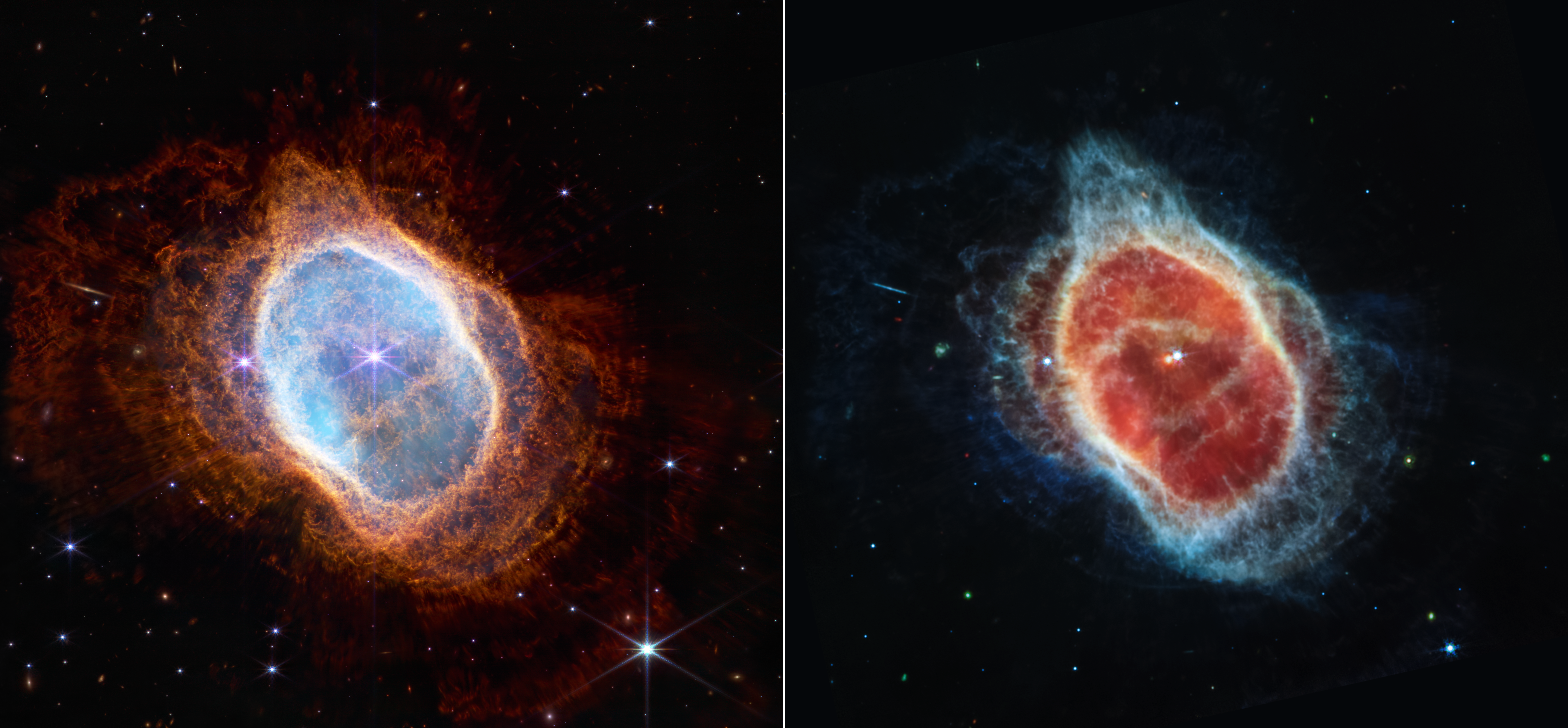
Southern Ring Nebula (NIRCam and MIRI Images Side by Side)
This side-by-side comparison shows observations of the Southern Ring Nebula in near-infrared light , at left, and mid-infrared light , at right, from NASA’s Webb Telescope. This scene was created by a white dwarf star – the remains of a star like our Sun after it shed its outer...
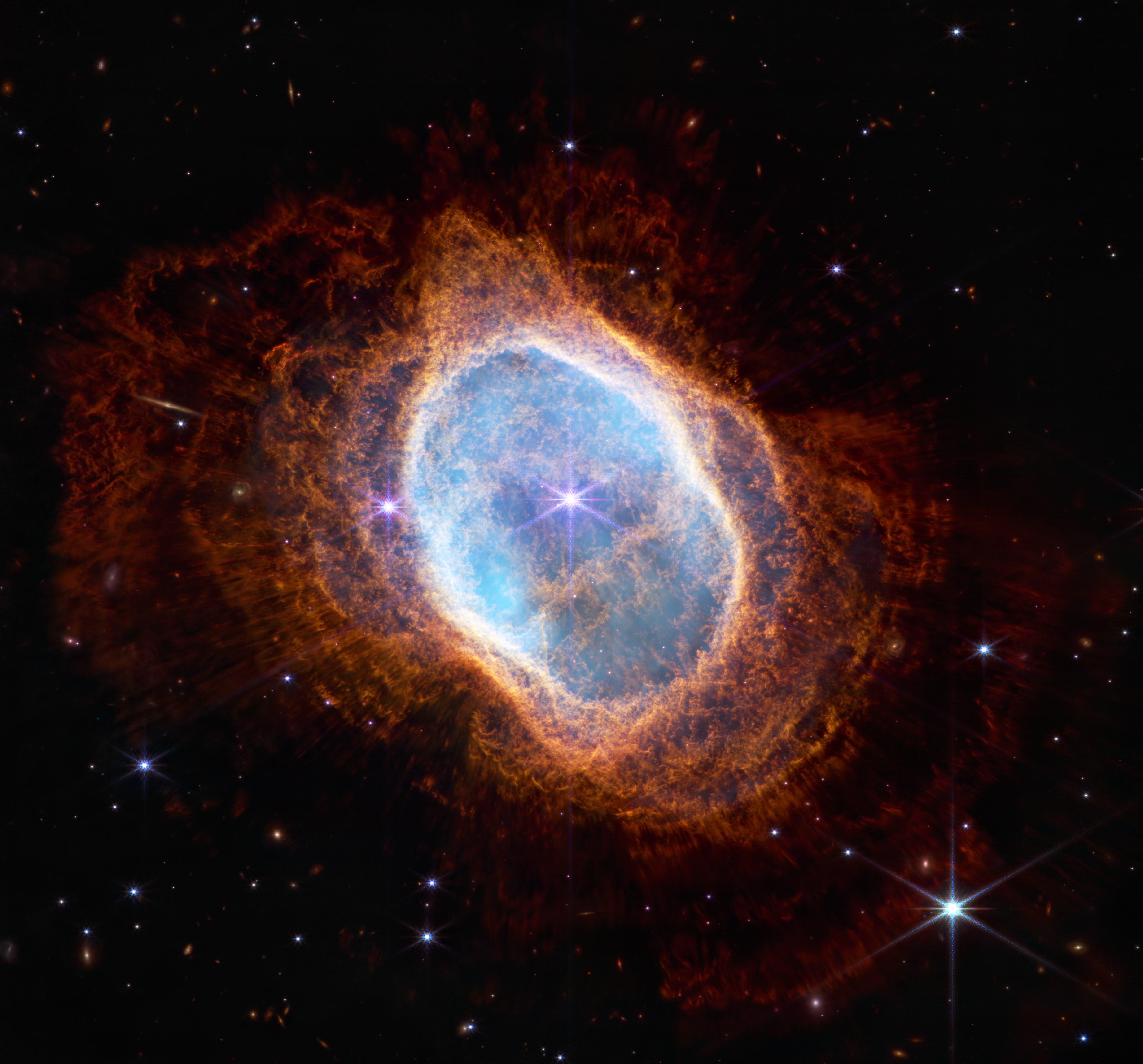
Southern Ring Nebula (NIRCam Image)
The bright star at the center of NGC 3132, while prominent when viewed by NASA’s Webb Telescope in near-infrared light, plays a supporting role in sculpting the surrounding nebula. A second star, barely visible at lower left along one of the bright star’s diffraction spikes, is...
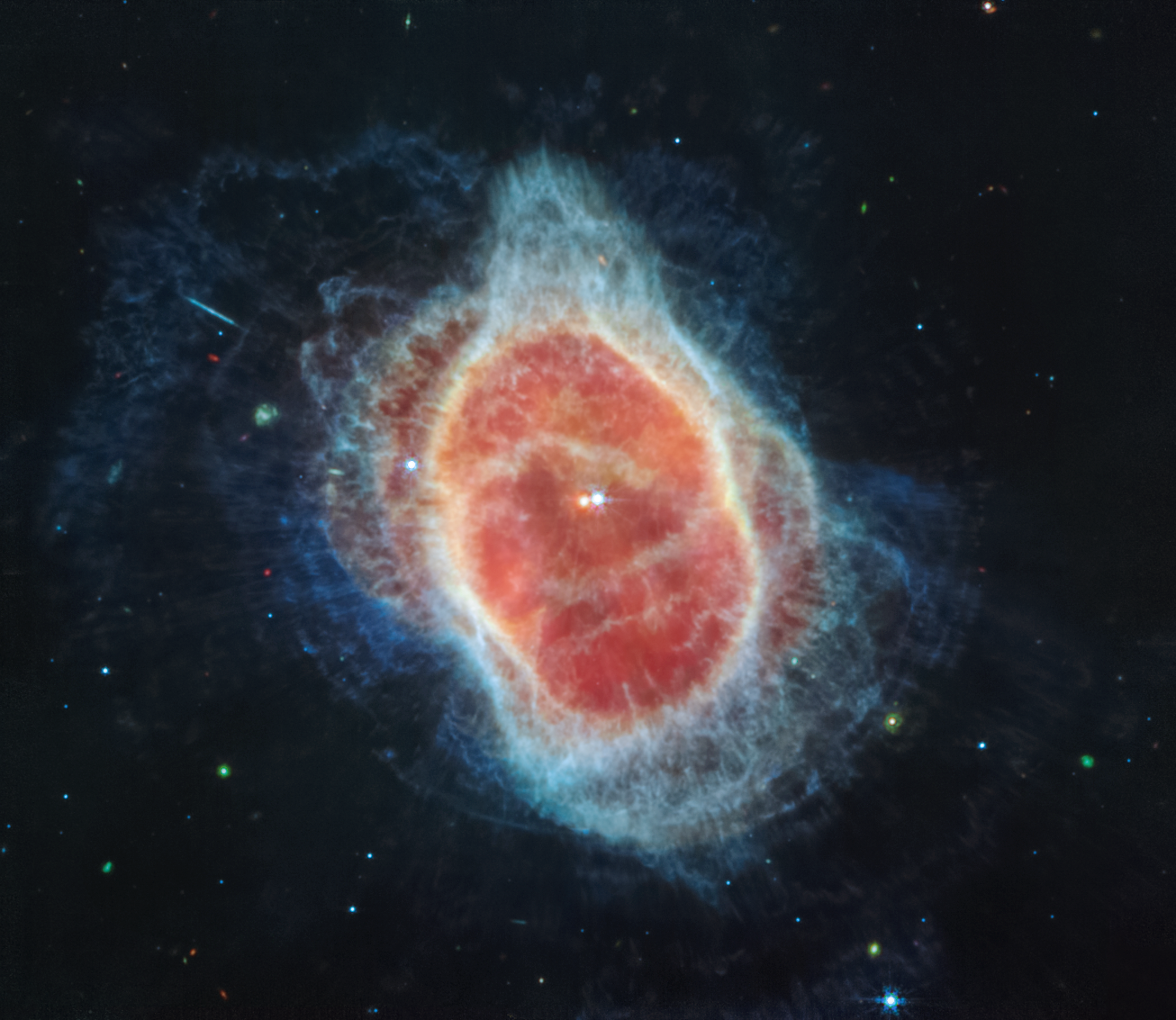
Southern Ring Nebula (MIRI Image)
NASA’s Webb Telescope has revealed the cloak of dust around the second star, shown at left in red, at the center of the Southern Ring Nebula for the first time. It is a hot, dense white dwarf star . As it transformed into a white dwarf, the star periodically ejected mass – the...
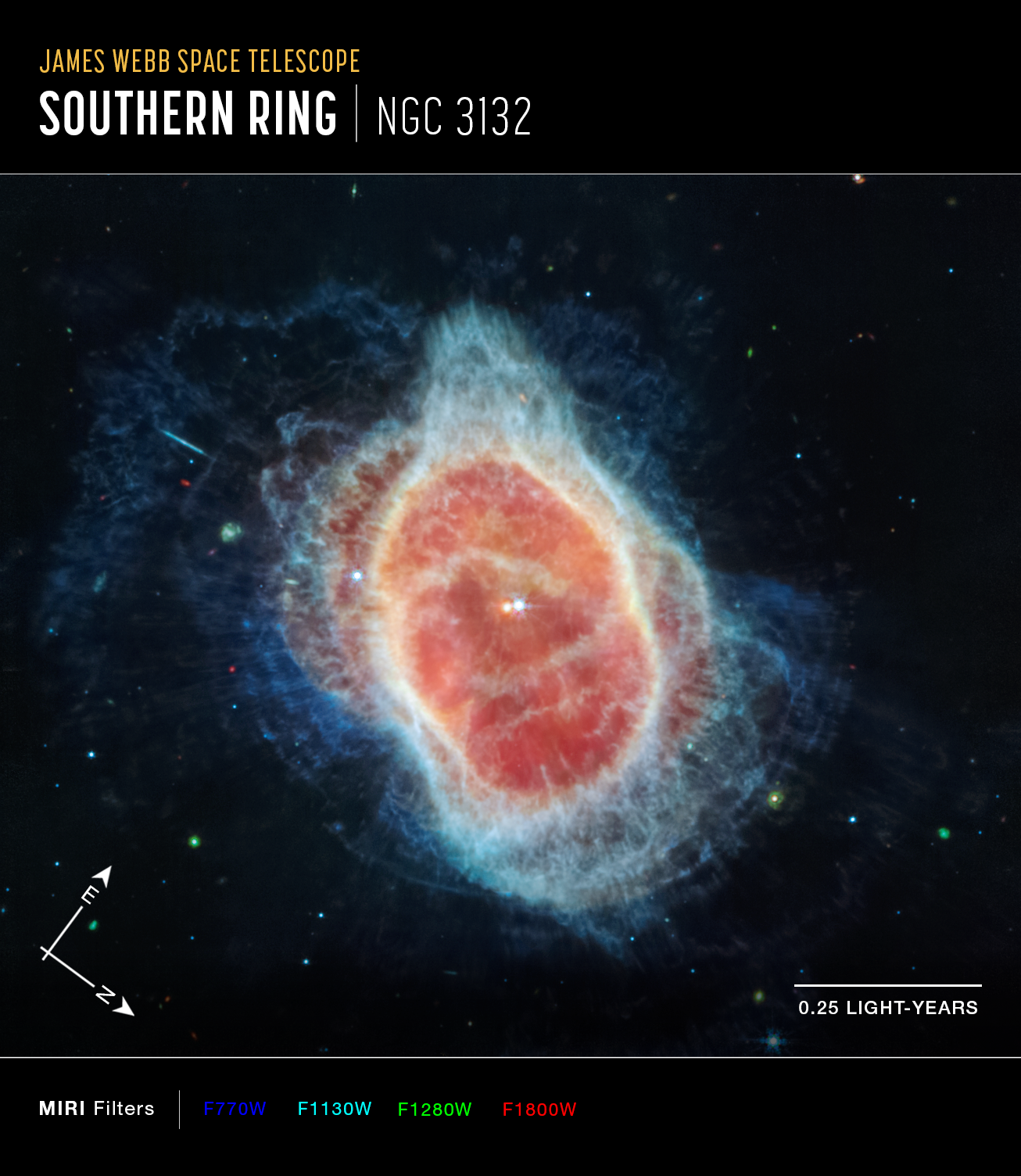
Southern Ring Nebula (MIRI Compass Image)
This image of the Southern Ring Nebula (NGC 3132), captured by Webb’s Mid-Infrared Instrument (MIRI), shows compass arrows, scale bar, and color key for reference. The north and east compass arrows show the orientation of the image on the sky. Note that the relationship between...
Share
Details
Laura Betz
NASA’s Goddard Space Flight Center
Greenbelt, Maryland
laura.e.betz@nasa.gov
NASA, ESA, CSA, STScI






























